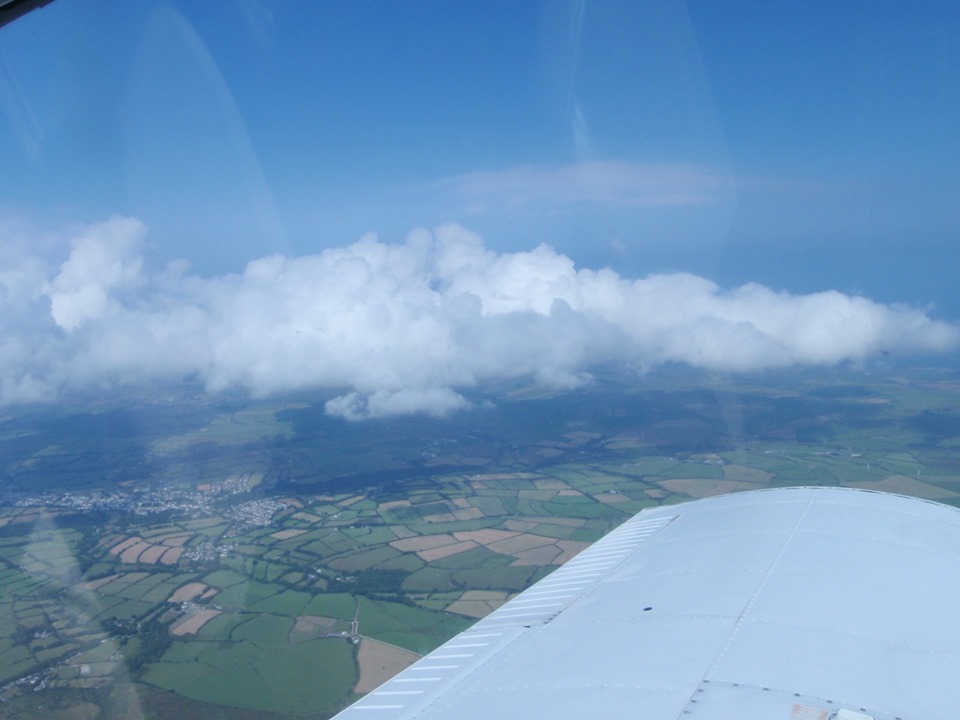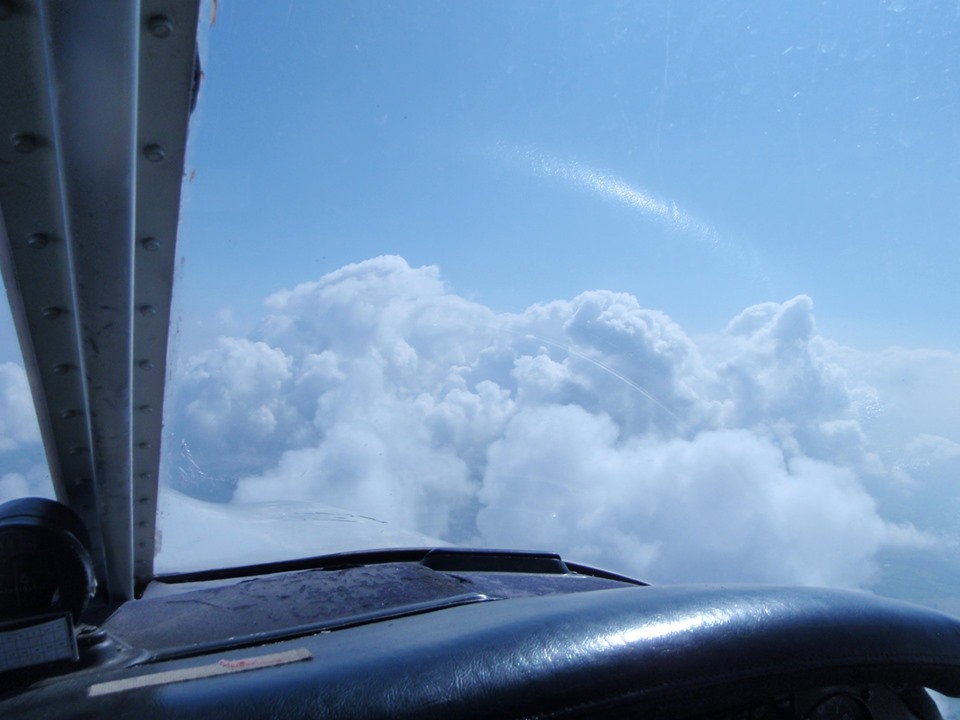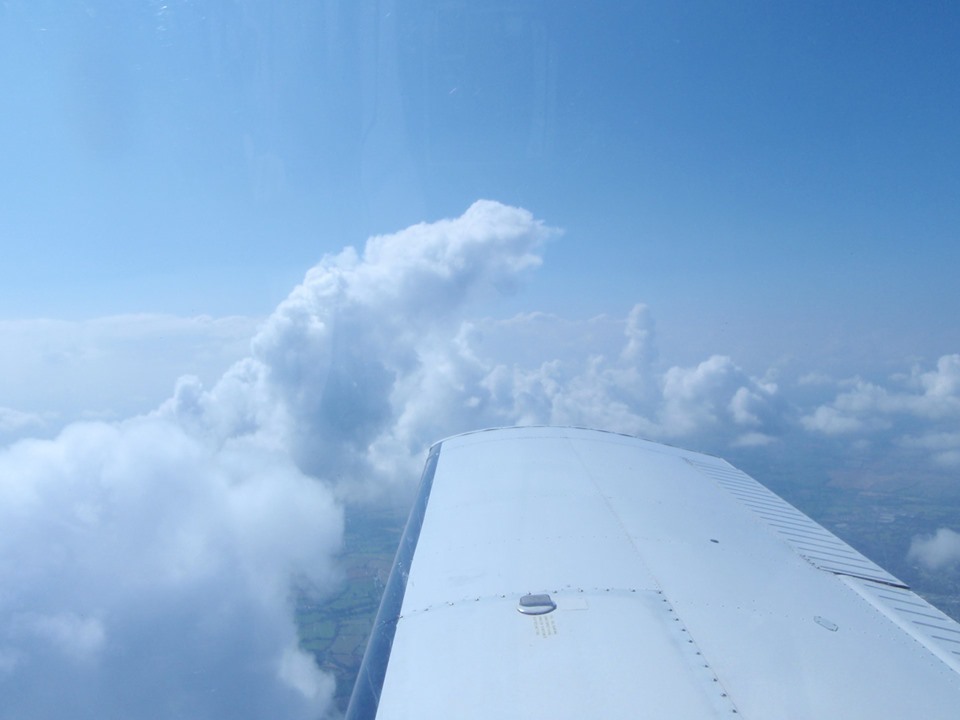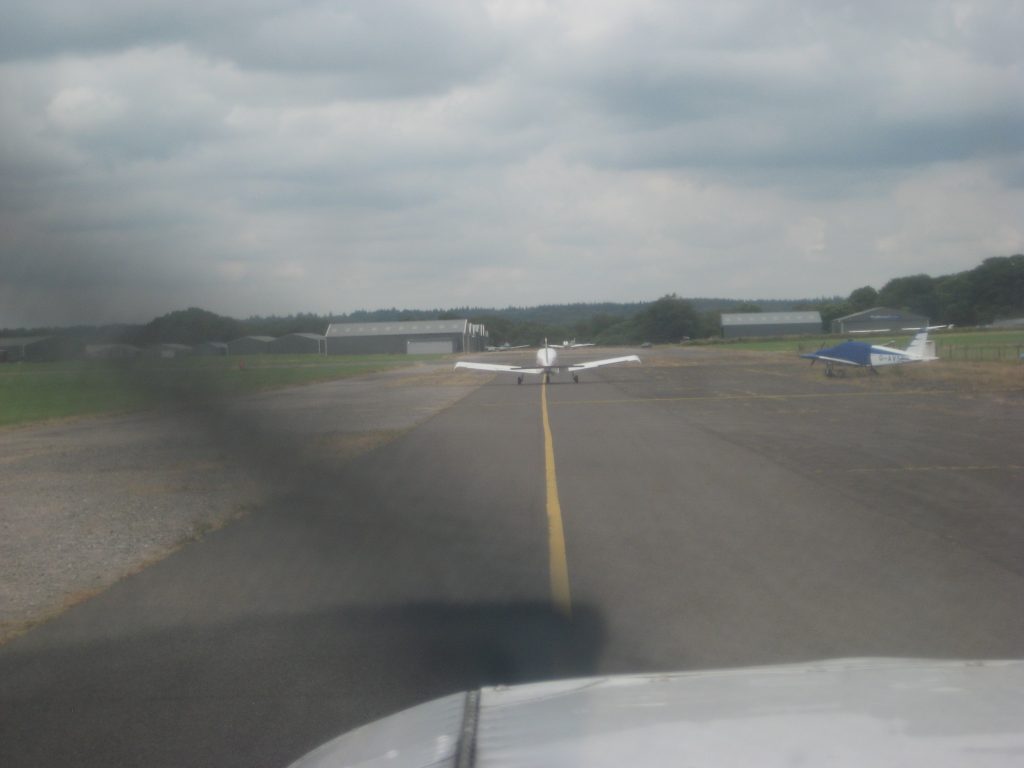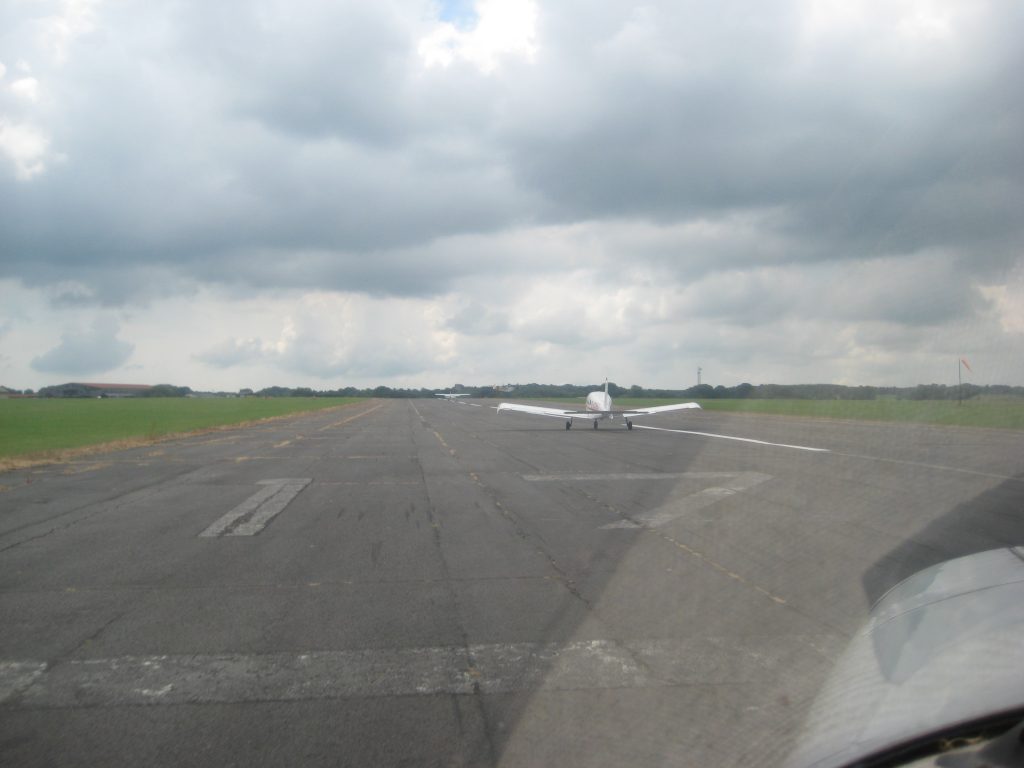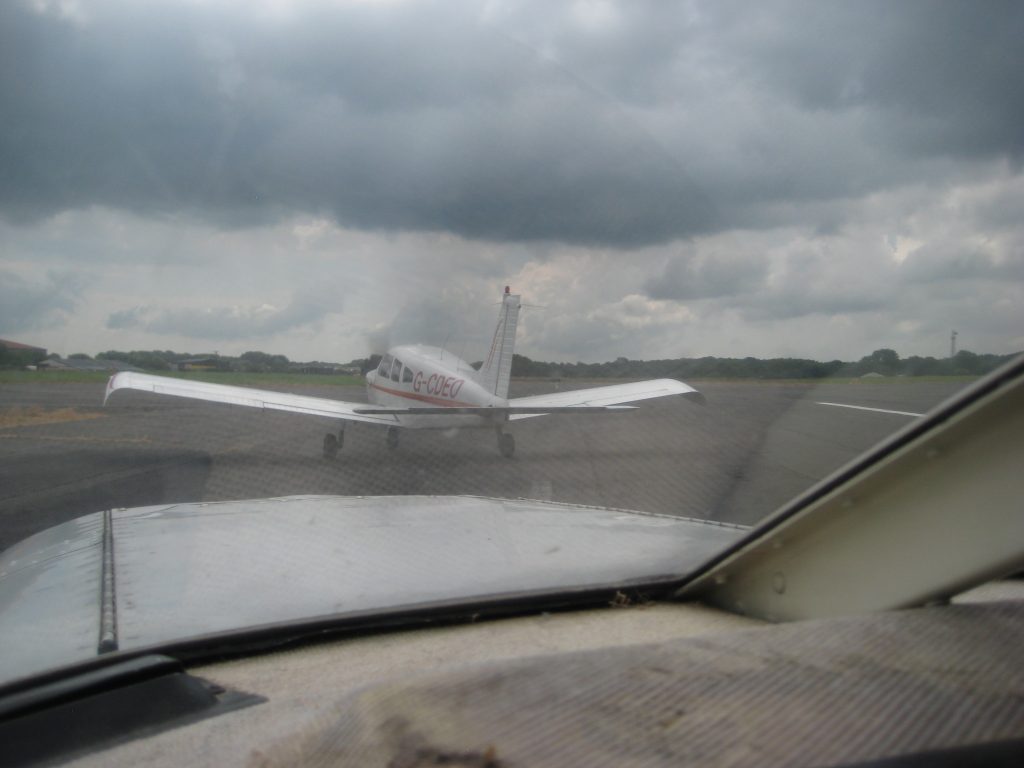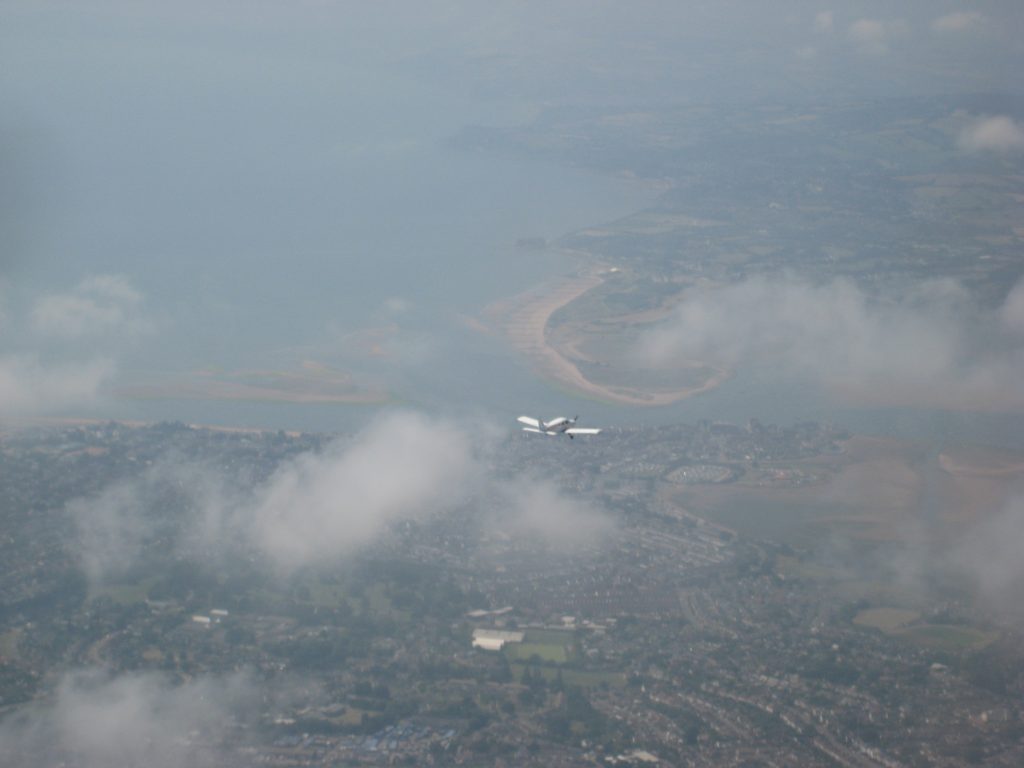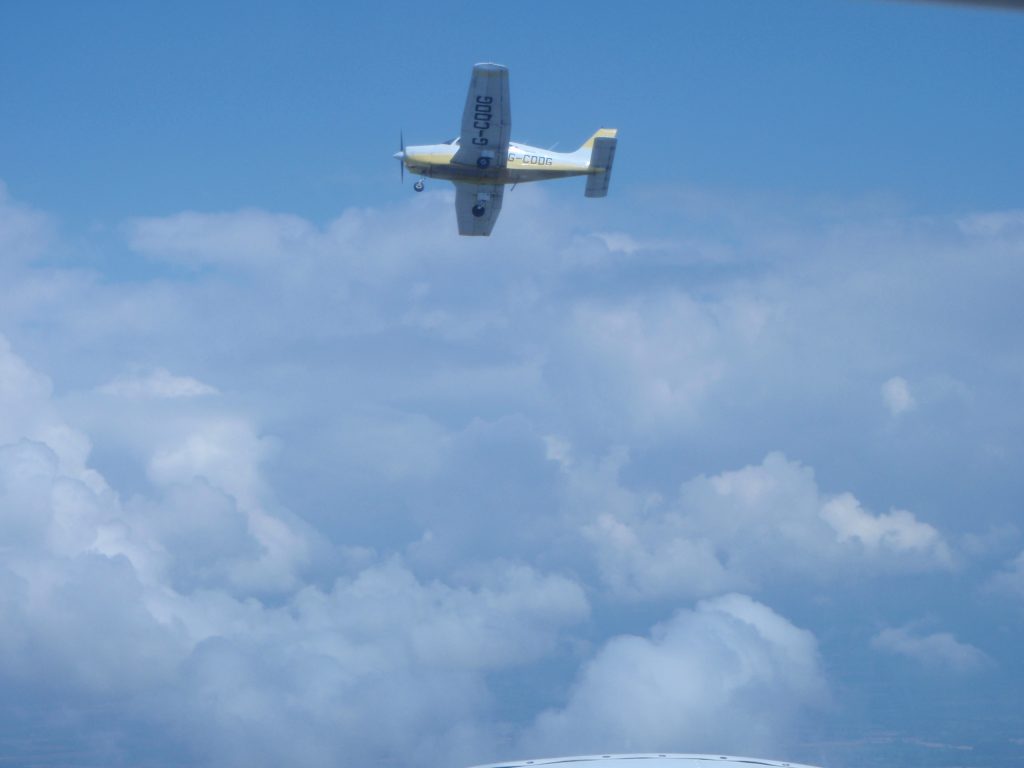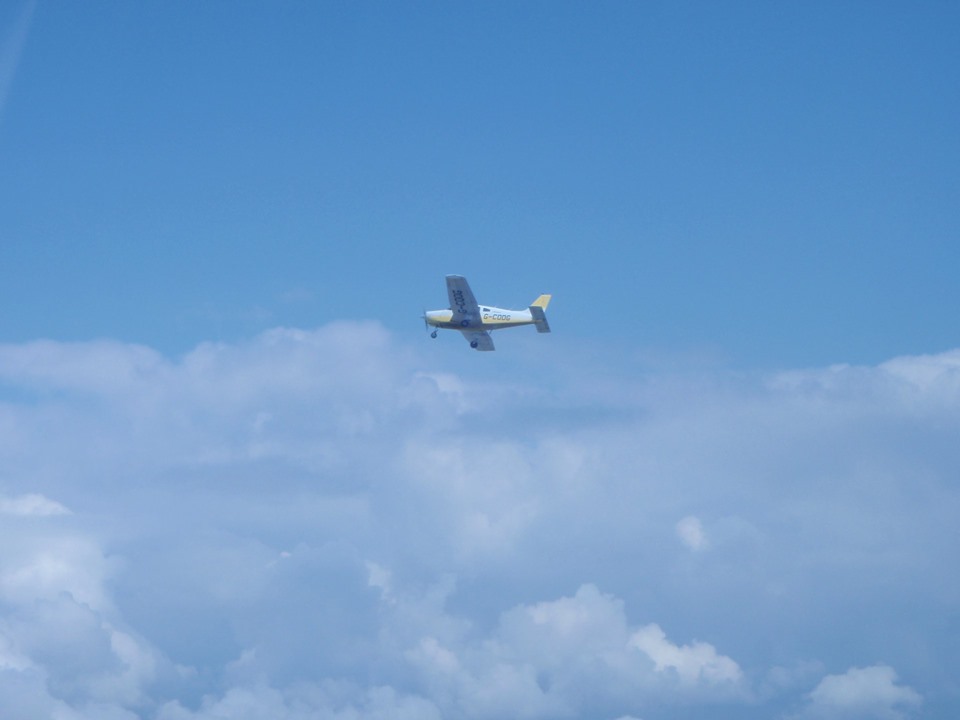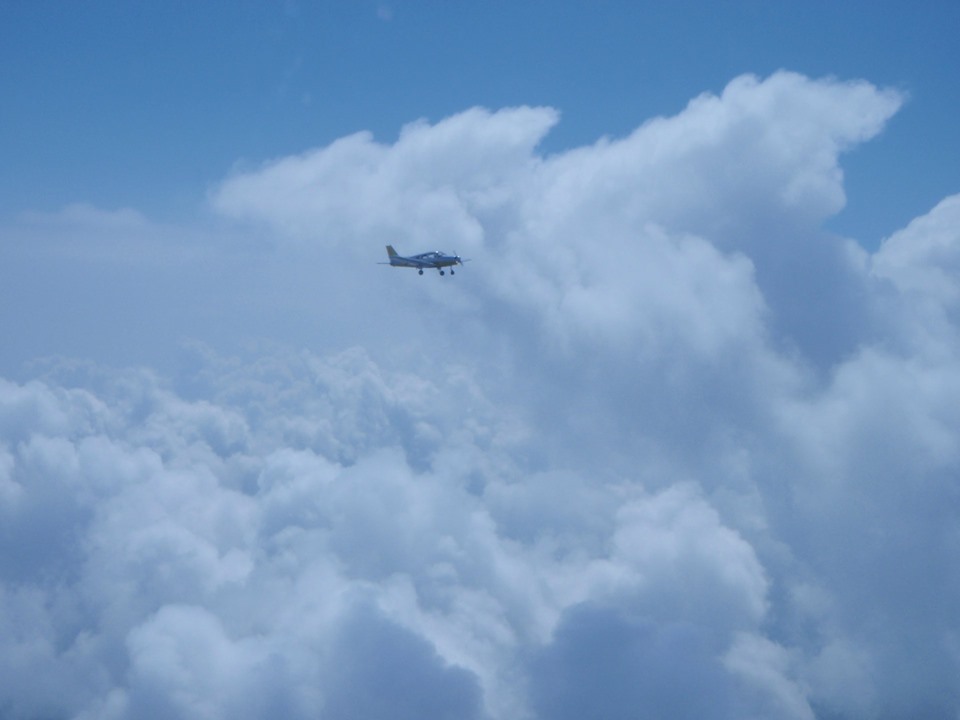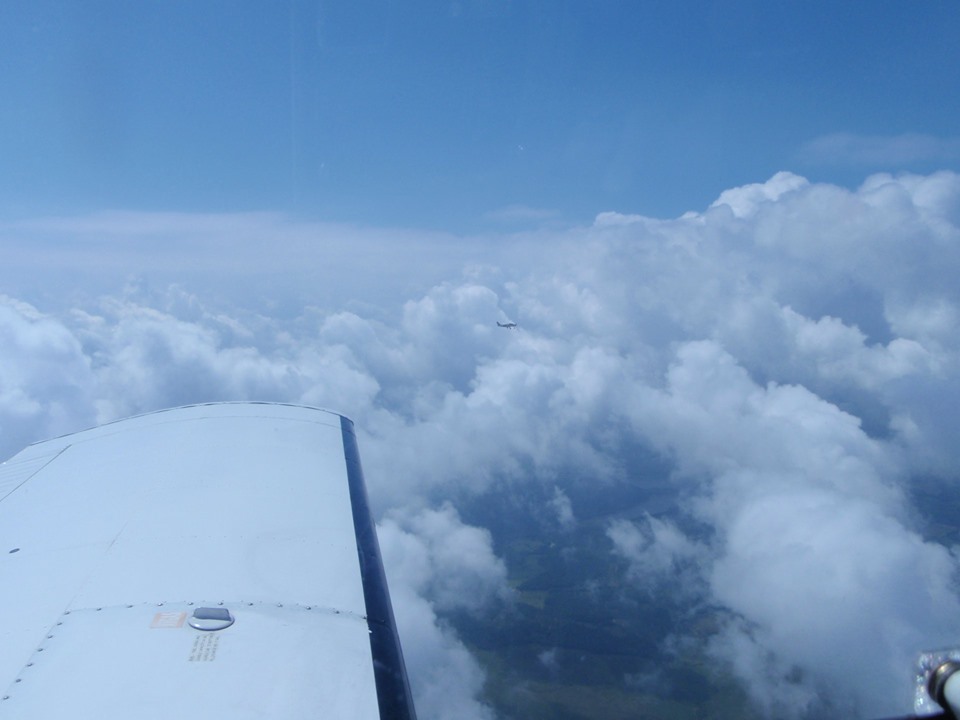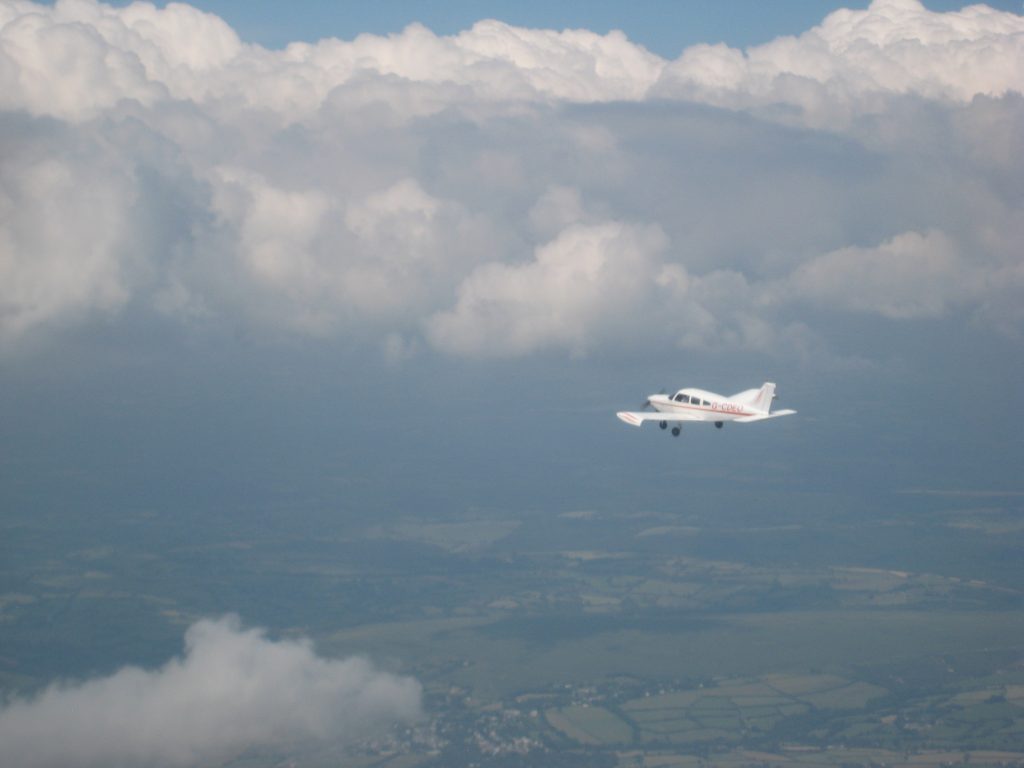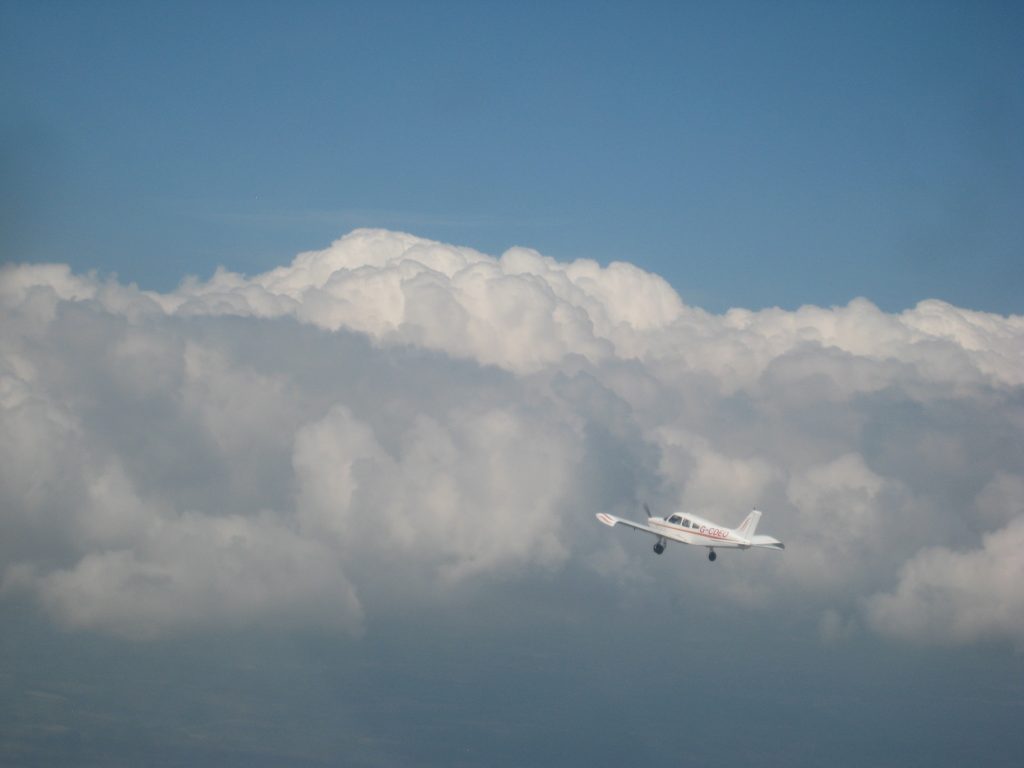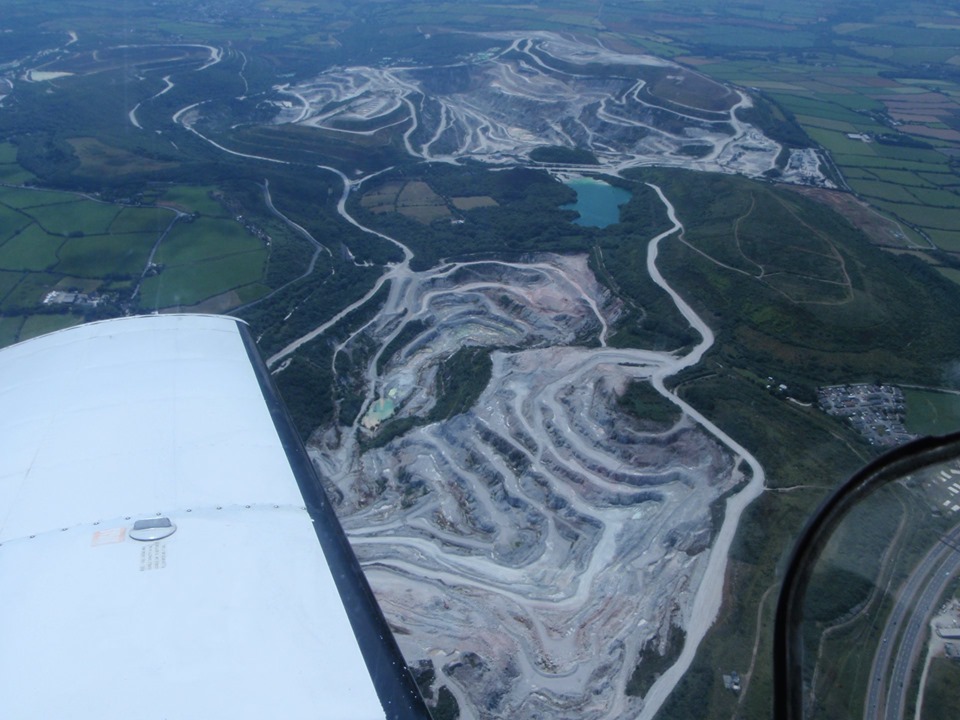“Exeter Radar, good morning; Golf Charlie Delta Delta Golf for basic service”
“Golf Charlie Delta Delta Golf , Exeter Radar, good morning; pass your message”
“Golf Charlie Delta Delta Golf, PA-28 out of Dunkeswell, in company with Golf Charlie Delta Echo Oscar, two thousand five hundred feet on one-zero-two-four, VFR navex and, er, basic service please”
“Golf Delta Golf, basic service, squawk five-zero-seven-one, Exeter QNH one-zero-two-three; will you be returning to Exeter?”
“Golf Delta Golf, squawking five-zero-seven-one, basic service, one-zero-two-three, and affirm returning to Exeter”
So yes, I had bogged up my ‘pass your message’ response, which should have been a concise and accurate summary of my flying intentions.
What I should have said was, “Golf Charlie Delta Delta Golf, PA-28 out of Dunkeswell in company with Golf Charlie Delta Echo Oscar, returning to Exeter after navex, heading one-eight-zero degrees at two thousand five hundred feet on one-zero-two-four, planned turning points at Sidmouth and Tavistock, VFR and requesting basic service”. * Quite a mouthful, but getting it right is important to me. And sadly I never get that bit right.
You’d have thought after over 20 years of flying, I’d have known better, wouldn’t you? But this time I had an excuse, or at least a reason 🙂
You see, the phrase, ‘In company with’ meant that on that day, a couple of weeks ago, I was flying with another aeroplane, this one being flown by my son David, who is a much better pilot than I am. His aeroplane, a PA-28 Archer, a variant of the PA-28 Warrior II I am flying but slightly more powerful, is based at Perranporth Airfield in Cornwall, not far from where he lives, whereas ‘my’ aeroplane is based at Exeter. ‘In company with…’ also lets the operator know that we are aware of each other’s proximity and he doesn’t need to warn us about each other.
And this flying ‘in company’ was one of the hardest things I have ever done in my entire flying career.
I will explain why it was so hard later. But the reason my radio message was somewhat patchy was due to the intense mental and physical workload involved in flying in fairly close proximity to another aeroplane. Our priority is this: “Aviate – Navigate – Communicate” and the ‘Aviate’ part was occupying my whole attention, with hardly any mental space for ‘Navigate’ and ‘Communicate’ was coming in a very poor third.
I mean it’s not as if it’s even anywhere near proper formation flying, like within a few yards of the other aeroplane. We stayed at least a hundred yards away, usually more like two hundred plus. But remember that a huge part of Pilot training is about the avoidance of other aircraft, and the idea of staying as far away from other users of the sky as possible. So to deliberately fly within a couple of hundred yards of another aeroplane is really, really counterintuitive for us. And remember that it’s the first occasion on which we have really done anything like this, at least for an extended length of time. And such concentration leaves very little mental capacity for other tasks.
Anyway, less of the words. Let’s have some pictures. Most of these shots, the flying ones at least, were taken by just pointing a crappy camera in the general direction of the target, and hoping for the best. The light was too bright (it was a really sunny day) to be able to see the cameras’ screens properly. But still they came out pretty well, I think.
Beginning with some of David’s photos, then, here’s the view from his Archer as he flies past Camelford in Cornwall, en route to Dunkeswell where we’d arranged to meet up.
On this particular day, there was a ‘ridge’ of high pressure over the southern part of the UK, bringing with it a little bit of murkiness under the cloud, and also a broken cloud layer consisting of huge towers of cumulus. To use David’s words, “…some of [the cloud] can be flown over…”
” …and other bits that you just have to go around!”
Meanwhile, on the ground at Dunkeswell, I have already landed after my short flight from Exeter, and I am chatting with a young man who’s about to do his first sky-dive. Trying to encourage him, you know 😉 So here’s Delta-Golf on the grass at Dunkeswell. I’d hoped to get a photo of the two aircraft together, but David was asked to park in a place about fifty yards away from my aeroplane, so I didn’t get chance.
I had my airband receiver with me, so I heard David arrive on the Exeter Radar frequency, then followed him as he switched to Dunkeswell’s air-to-ground radio frequency. A greaser of a landing later (yes, that’s a good thing!), he taxied over to the parking area and we met up. Over a picnic lunch, we planned our upcoming sortie in great detail. Positions we would fly in, radio frequency plans including loss-of-contact planning, procedures for changing ‘formation’, who would lead, who would trail, how we would do our taxying, power checks and takeoffs, the works. No stone was left unturned; planning is vitally important when considering a venture like we were going to do. Given that neither of us had previously really flown in any kind of proximity to another aeroplane for any appreciable length of time**, this was all new to us and therefore we had to thrash it all out on the ground, before setting off. Plan was this: David had the lead, sequential trailing takeoffs, fly out to Sidmouth, then turn for Tavistock on the other side of Dartmoor. Stick with Exeter Radar until we get to Bovey Tracey, then switch to SAFETYCOM frequency on 135.475 so that we can talk plane-to-plane.
So we started up and taxied across the airfield using the taxiways…
…moving slightly across to let another aircraft with a rude pilot come past (he’s off-camera to the right)…
…and then it was time to stop and conduct our power checks and pre-takeoff vital actions:
The strange, downwards-curved wingtips on Echo-Oscar are a modification kit that improves the efficiency of the wings and gives a better fuel economy – of the order of an impressive ten percent. It looks weird, but she flies well.
Since Dunkeswell is not a commercial aerodrome, where only one aeroplane would be allowed on the runway at a time, we lined up on the runway together and David set off first. The very second he lifted off, I opened my throttle and commenced my takeoff roll. Lifting into the air very quickly and not too far behind him, I managed to keep David’s aircraft in sight, although with a white aeroplane against a white/grey background, it was extremely difficult and I lost sight of him a couple of times.
Given that we were climbing, we were both at full power, and it was difficult for me to keep up; I finally caught up with him about ten miles out when we were nearly at Sidmouth. The first photo opportunity came when we had turned over Sidmouth and were over Exmouth; this gorgeous photo shows David over Exmouth with the mouth of the Exe estuary in the background, showing Dawlish Warren to good effect.
Although David knew I was ‘around’, he wasn’t sure whether or not I was actually in visual contact with him as we couldn’t talk to each other – we were on Exeter Radar’s frequency where we can only really talk to the radar operator. But he carried on with the navigation plan as we’d arranged, and just had to assume I was there. The position I am in in the above photo, in David’s five o’clock high, is a near-blind spot where he would not have been able to see me unless he knew where to look.
At this point, I began to overtake David to his right, so he’d be able to see me if he looked in the right place. Which he did, and happened to take what is probably the best photo in this entire set. I’d drawn alongside to the right but was slightly high, and as he passed under my left wing I realised I couldn’t see him, and so began a gentle, climbing turn away:
…and continued the turn for good separation, before I felt comfortable enough to turn back parallel to him again:
Job done. Note that if you can’t see the pilot’s face (or even the window), then he can’t see you. So because you can’t see my cockpit window in the above photo, it means that David’s aeroplane was invisible to me at that point. And at only a couple of hundred yards away, that’s pretty scary.
You see, it’s all very well when the aircraft are pootling along in the same direction, with little relative motion. Everything is moving in the same direction at the same speed, so it all looks like everything is standing still. But the moment you take any other heading apart from dead parallel, your velocity difference becomes immediately and frighteningly apparent. Because you’re doing about 100kt, which is about 114mph, you’re actually going very fast indeed. So convergence or divergence of your headings can happen very quickly. And if you were to turn at 90 degrees across the other aeroplane’s track, that would mean that your relative velocities would be in excess of that 100kt; you turn 90 degrees behind him and then it is immediately obvious that his aeroplane is moving away from you at high speed. Or, if you should cross in front at that speed and angle, that is going to be very dangerous indeed. At those sorts of speeds, things happen blindingly fast; faster even than my really lightning-fast reactions can cope with. So it’s important to use slight heading changes rather than drastic ones, hence my gentle turns in the photos above. This flight was in fact a safe if salutary lesson in how fast things can ‘develop’ (read: go pear-shaped) up there in the sky.
So, we got as far as Bovey Tracey, terminated the radar service and switched to SAFETYCOM. Now, we were able to talk ship-to-ship and that made things much, much easier. No need to second guess each other’s intentions; now we could just tell each other straight.
Somewhere over south Dartmoor, David took this photo of me formated on him in echelon port, about 200 yards away. Although this doesn’t look or sound all that close, in real life the other aeroplane looks frighteningly large, and you are painfully aware of your mutual proximity. The aircraft looks a lot bigger at this distance, in real life, than the photos suggest. You may even have some personal experience of this yourself; you’ll probably have taken photos of aircraft at airshows; when you took the photo the aeroplane was like right there and looking really big, but when you look at the photo later, the aeroplane is like a small dot. That’s what this is like.
And here’s a similar shot, but just not as zoomed in. That’s me in that tiny dot in the distance. Again, it looks miles away but in reality it wasn’t:
So, why is flying ‘in company’ so hard? Well, I’ve already talked about how things can change really quickly when flying this close to another aeroplane. At the kinds of ranges we are looking at here, just a couple of seconds’ inattention can result in a velocity change (speed or, more likely, direction) that can result either in getting too close or in losing visual contact with the other aircraft altogether, which is worse in some ways because he might be right there and you don’t know about it. Therefore, as well as having briefed preflight on breakaway procedures, as the trailing aircraft you’ve also got to keep your gaze more or less locked on the other aircraft – we call it being ‘padlocked’ – and there’s no time really to do much else. That’s mainly applicable for the trailing aircraft because the lead aircraft is simply flying straight and level and on course. Things like checks of fuel pressure, changing fuel tanks, oil temperature/pressure, compass synchronisation, carburettor icing checks and all the other routine chores involved in flying a plane; all these things become subservient to the overarching concerns of a) not hitting the other plane, and b) not losing him either. I have read anecdotes from fighter pilots where they say that in one moment the sky is full of planes; in the very next second there’s not a plane to be seen. I can see how that is possible. Think about it like this: from directly astern (behind), the cabin and fuselage cross-section of a PA-28 is something of the order of a five-foot square. Out of this five-foot square poke two wings which are almost invisible from astern at any kind of distance, because they are not much thicker than about eight inches or so. Added to that, the plane is painted mainly white and it’s glossy, all of which means it’s very difficult to see against a cloud backdrop, in haze, or against a hazy underlay. So unless you keep your eyes fixed on him all the time, it’s just so easy to lose sight even when you know exactly where to look. That’s the main thing that makes it so hard. I have absolutely no doubt that it becomes easier with practice and training, but for us, on that day, it being our first time, it was unbelievably difficult. But huge respect to people like the Red Arrows and The Blades, who routinely fly with only feet separating them from their neighbours. And that’s with more than just two aircraft in the formation, too. I would imagine that greater aircraft numbers will really complicate things way beyond what it’s like with a two-ship formation. Formation flying is hard enough with two aeroplanes straight and level. With four, or nine, aircraft and doing aerobatics too (which are also difficult), it’s just insane. Seriously, respect to these guys…it’s only when mere mortals like us do what we have done so tentatively, that we can really appreciate what these guys do. Amazing.
Now we were in radio contact, David also got a chance to formate on my aeroplane, as I took the lead for a spell:
And then, at 5,000ft and coming up on Tavistock, our scheduled separation point, I got this lovely shot of Echo-Oscar:
The Devon town of Tavistock is visible below the cloud there, and nearly a mile of vertical distance below us, and I think this shot captures as well as any other the glaringly obvious point that there is nothing holding us up. Just the wings, using the marvellous natural effect that happens when you change airflow over a curved surface and generate lift. It really is quite remarkable that literally thin air can lift (in the case of a PA-28) the best part of a ton of metal, fuel and flesh up into the sky, where it really has no business being. And of course that’s just a light aircraft; there are of course many, much bigger, aeroplanes, all of which fly because of the same principle. I find that amazing.
But eventually we had to part and go our separate ways. From just west of Tavistock, David continued on course for Perranporth, and I turned for my return flight to Exeter. Here’s David’s Echo-Oscar just before I broke away:
Even then, things were complicated slightly in that my intention was to break away high and left, and perform a 180-degree turn onto heading for Exeter. But directly to my left was a towering cumulus cloud that stretched a good couple of thousand feet above my level and there wasn’t space to get round without going into cloud. So I had to make an on-the-spot decision – such a common occurrence in flying that I am well used to it – but basically I turned away only some 30 degrees in a climbing turn to the left, towards the cloud but not all the way towards it, and then reversed my turn and turned right and away from the cloud, still climbing, and crossed David’s wake about half a mile behind him and three hundred feet higher. We’d said our farewells before I began the turn, maybe we should have waited to do that until we were heading away from each other. Well, we’ll know for next time.
My flight back to Exeter was uneventful; David took a couple of photos, though, including his first ever airborne selfie:
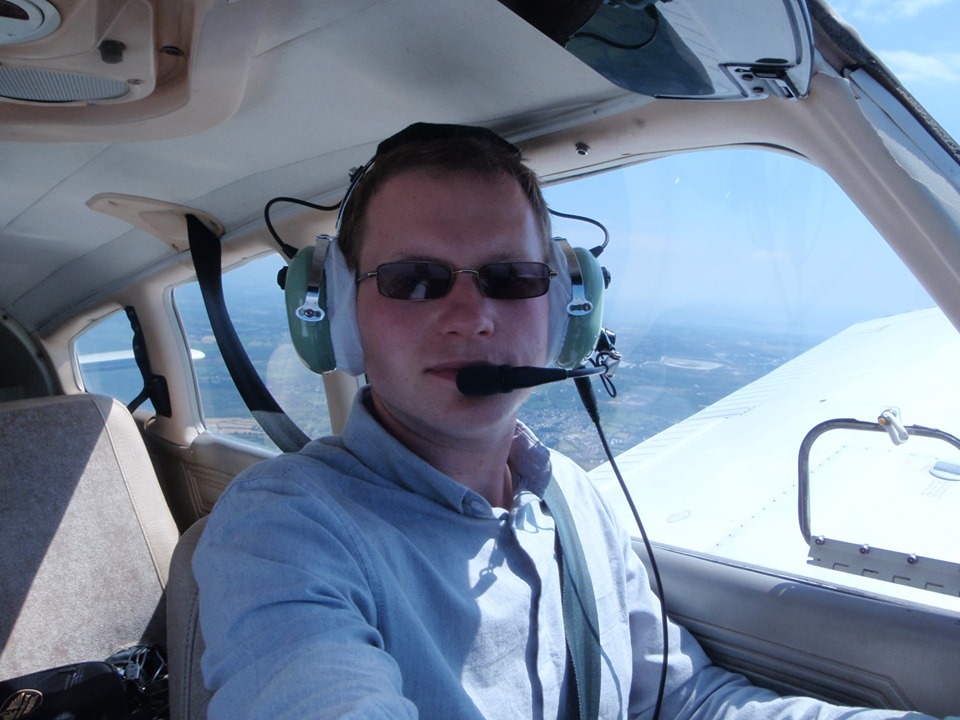
(see how he’s got the same kind of headset as mine; we got him it for his 30th birthday 🙂 )
…but he also got some spectacular views like the claypits (china clay quarries) at Indian Queens near Newquay:
So, there we go. An awesome flight where we learned so much***, and had so much fun. Things to learn from this flight, just off the top of my head: I would probably have wanted direct radio contact much earlier in the flight to maintain situational awareness and mutual location; better briefing on how to find each other; maybe do more aeroplane checks but again in radio contact, so we can warn the lead aircraft to keep it straight, maybe setting a slightly divergent heading while doing the checks. Also, carry a photographer rather than doing it myself 😉
But all in all a great experience. Still buzzing from it, over a week later!
Peace and Grace 🙂
*English translation:
‘Golf Charlie Delta Delta Golf’ is my aircraft callsign; it’s the phonetic alphabet rendition of the registration letters on the side of the aircraft. It’s usually shortened to ‘Golf-Delta-Golf’ by controllers, or just ‘Delta-Golf’ by flying school staff and pilots. ‘Which plane are you taking today?’ ‘Delta-Golf’.
‘PA-28 out of Dunkeswell in company with Golf Charlie Delta Echo Oscar’ – Aircraft type is a PA-28, and we’d taken off from Dunkeswell, an airfield near Exeter Airport, where it’s cheaper for David to land. And I fancied a landaway anyway.
‘Returning to Exeter after navex’ – that’s my destination airfield, and a ‘navex’is a ‘navigation exercise’.
‘Heading one-eight-zero degrees at two thousand five hundred feet on one-zero-two-four’ – refers to the direction in which my aircraft is pointing, so the radar operator can see which aircraft I am. One-zero-two-four refers to the pressure setting – the ‘QNH’ – on my aircraft’s altimeter, so the operator knows what pressure setting I am working from in order to determine my altitude. This needs to be the same for all the aircraft he is working with, so that all their altitudes are reported from the same reference point.
‘Planned turning points at Sidmouth and Tavistock, VFR and requesting basic service’ – tells him our intentions, that we are flying under ‘Visual Flight Rules‘, that is, decent weather flying where we can see where we’re going, and that we just want him to help us look out for other aircraft on his radar screen. Giving us an extra pair of eyes, as it were.
**The only previous time when we had done anything like this was once over Cornwall in 2013, where we had met up in the air by chance – we knew each other was up and around, but not exactly where – and David came up about fifty yards off my port wingtip. An awesome sight, but we each had our flights to do (he was doing a navex and I was training my daughter for an upcoming charity flight), so we didn’t stay like that for long.
***In addition to the lessons learned, there was something else too. David and I are both military historians. This flight gave us both a really strong appreciation of what it must have been like in air combat in World War II – or indeed any war – but especially WWII because of the ubiquitous use of air-to-air gunnery. Imagine a swirling sky filled with fast, small aeroplanes that are going at speeds in excess of 350mph and in a small volume of space, trying to keep formation with your wingman, trying to avoid collisions with aircraft friend or foe, and most of all trying to shoot down other aeroplanes. Given that the most effective range for using guns against other aircraft was of the order of no more than about 100 yards, and often much closer, we got a really good appreciation of how huge an enemy aircraft would appear when it is in firing range. Because of that, it’s also no surprise that many pilots opened fire at ineffectual ranges, like say 400-500 yards because, although the range was too great for effective fire, still the aircraft would look like a great big barn door target and therefore would look close enough. You had to get really, stupidly close in order to score any hits. Added to that things like deflection shooting (where you aim ahead of the target so that it flies into your bullet stream, like in clay pigeon shooting), bullet drop and other advanced ballistics, and that you had to actually point your aeroplane into a collision course with the target in order to shoot it – I mean it’s just insane! Pointing your aeroplane at another aeroplane at very high relative speeds, getting really close, and somehow not colliding with him…. it’s incredible to imagine how they did that, given the things we experienced on our ‘in company’ sortie. These were brave people indeed.

